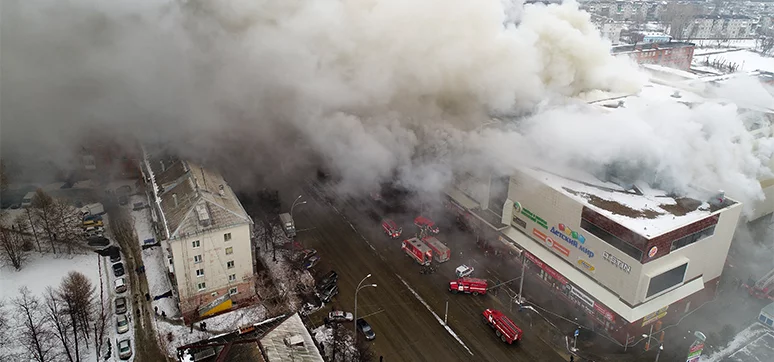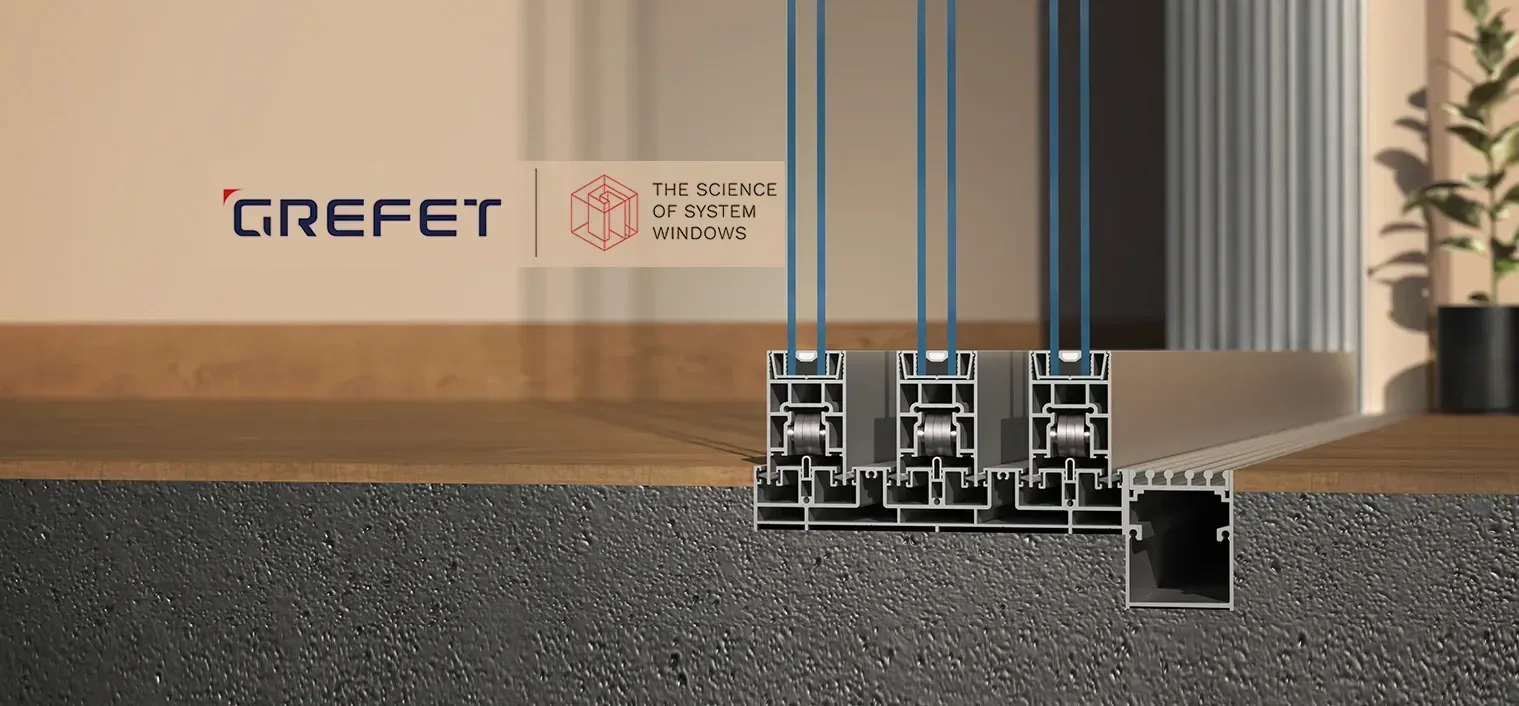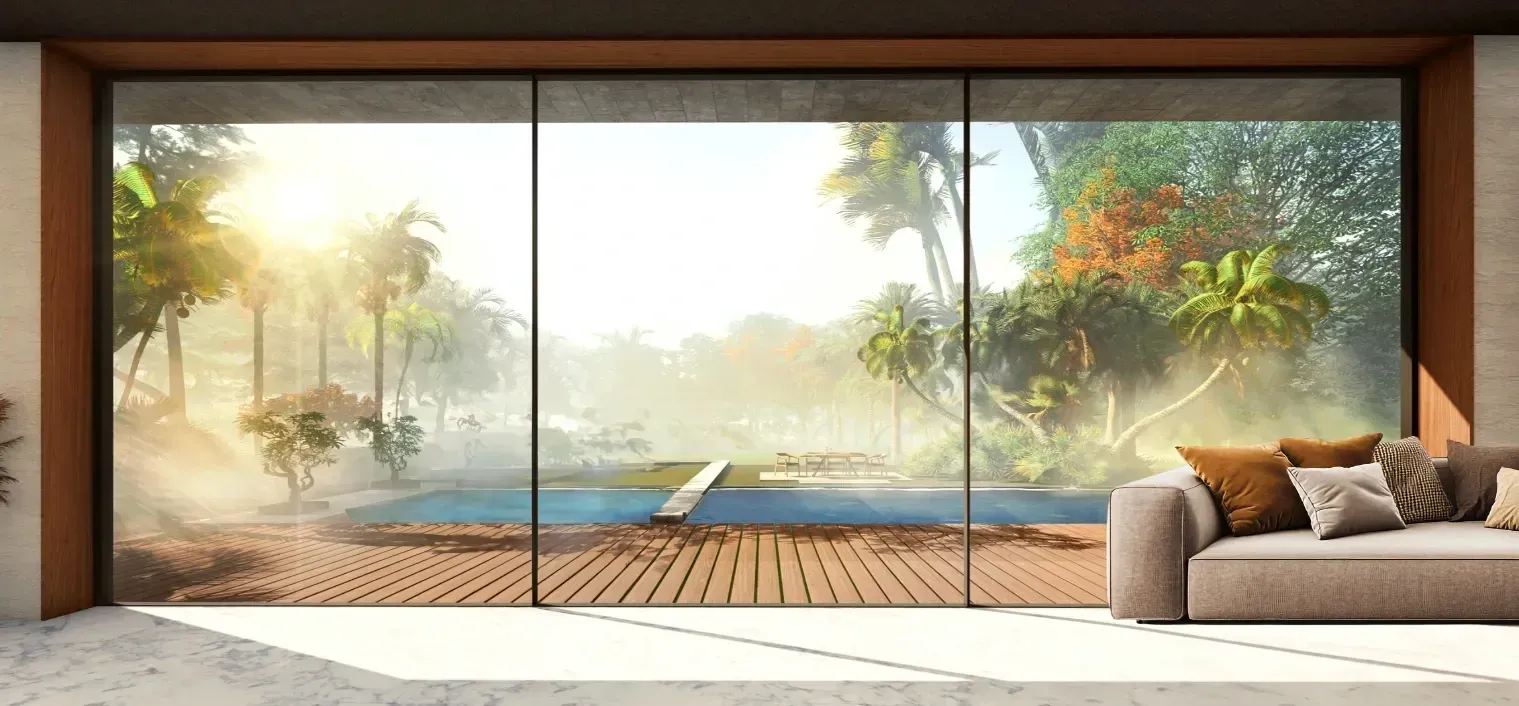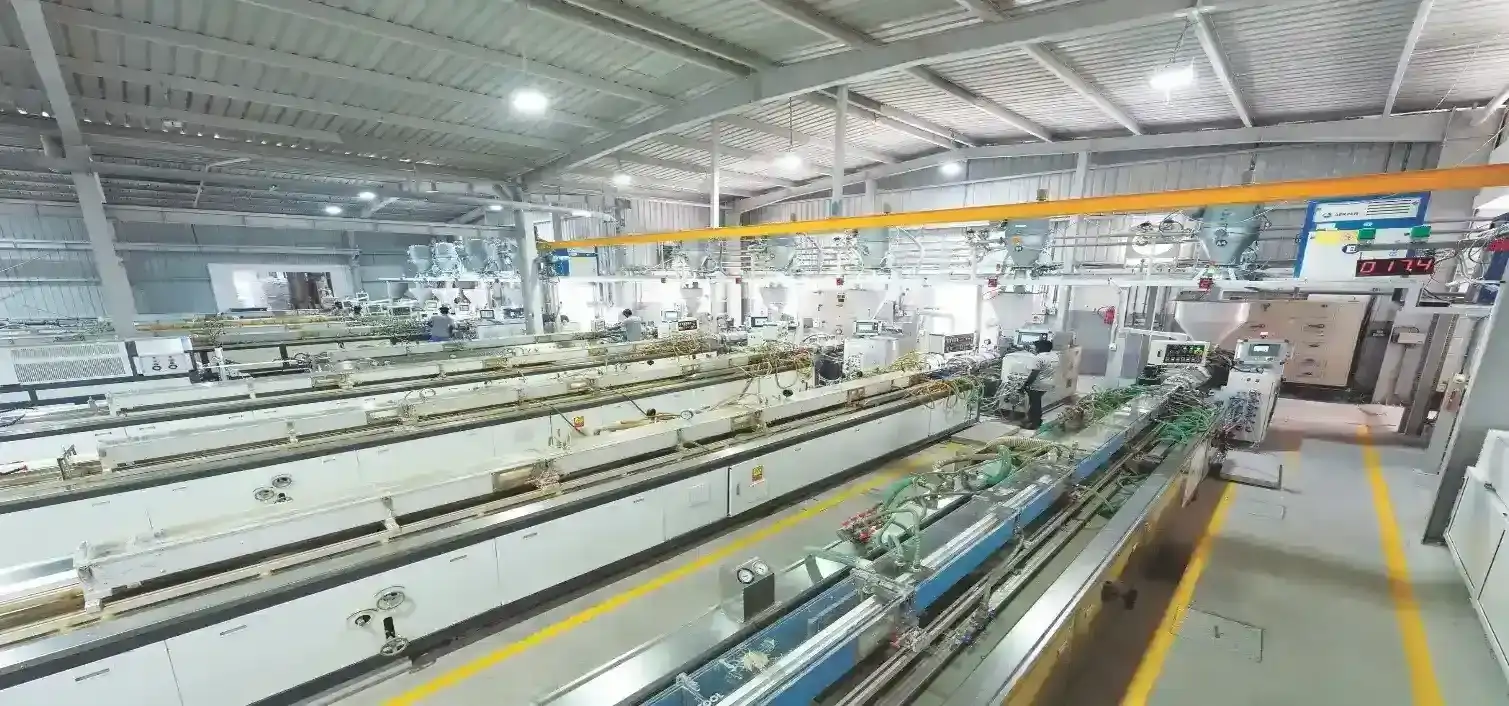Fires cause over 300,000 deaths annually and are the fourth-largest cause of accidental injury globally after road accidents, falls, and drowning. Burn injury risk is strongly associated with urban areas with crowded regions, which are growing rapidly in an urbanising world. Fires in high-rise buildings and residential complexes are one of the major urban disasters due to the high population density, and high economic value of buildings and land. The high concentration of people and property makes firefighting and evacuation operations very difficult in case of a fire event.
Team WFM discussed the factors affecting fire occurrence in highrise buildings with many experts including architects, engineers and consultants, and found that the main factors influencing the fire risks and spread of fire in buildings are fire safety evacuation ability, building fire prevention capability, and building fire safety management status.
Fire Safety In High-Rises In Dense Urban Areas

Real estate developers, architects, and/or the occupiers of the building have always explored and novel ways of making the construction more pleasing and appealing to the eye. This also helped to make the city line more forward-looking and decorative! In the past, say 20 to 25 years, architects used to provide elevation changes for having multiple planes rather than one-face buildings, observes Nikhil Kharkar, Practice Leader Consulting Solutions, Marsh Advisory.
With the advent of composite panels and its innovative and evolving designs, it is possible to provide numerous elevations, which earlier were quite impossible. With the global warming issue becoming more realistic and developing countries, including India pledging for reducing carbon footprint, we are now actively looking at ways as to how to make buildings more energy-efficient. Claddings and façades have been at the forefront in this aspect too.

In the absence of any horizontal space, rapid and unplanned urbanisation has pushed the vertical barrier much higher than ever before because of which we see high-rise buildings coming up in developing economies. This, coupled with the concern of reducing the carbon footprint and making the buildings more appealing through innovative façades has been increasing exponentially. The flip side of the above-sited positives is that that the plastics used can easily burn unrestricted across the vertical and horizontal face of the façade producing thick black smoke, adds Kharkar. Ar. Anuprita Dixit, Design Director, IMK Architects too points out that in times of growing urbanisation, the importance of fire safety in urban spaces must be seen. Fire can spread faster in areas with a higher concentration of high-rise buildings and narrow streets.

A major criterion governing building designs today is its fire-safety preparedness. On both the active and passive fireside, developers are required to ensure that a foolproof fire-fighting strategy is in place at the time of building handover, says Tariq Kachwala, Director, FG Glass. This criterion is most pronounced when we consider the development in a dense urban setting and more so when we look at high-rises. “A major challenge posed by high-rises in densely populated locations is the time it takes for people evacuation and for extinguishing the fire. The situation is compounded in our cities due to narrow lanes and high traffic levels. In such a scenario, it is imperative that apart from other building aspects, façade design and the choice of materials complements the overall fire-safety strategy for the construction,” adds Kachwala.
According to Ankit Sharma, Research Scholar, Mechanical and Industrial Engineering, Indian Institute of Technology, Roorkee, one of the major challenges in high-rise buildings is external fire, which is highly dangerous as it can engulf the whole building in a short time (Fig. 1). Façades which have frequently been used as a part of exterior applications is often one of the main reasons by which fire spreads externally to other floors. It is used to offer an extra level of rain and weather resistance and increasing the building’s energy efficiency. However, in the process of giving good visual appeal to the building, combustible materials are being increasingly used in these exterior façades which can easily catch fire as a result of different fire scenarios (Fig. 2).

The fire tends to spread, says Kharkar, in a vertical direction faster, so once a combustible façade is involved in a fire, it can spread unrestricted vertically and in the horizontal direction. Under specific conditions such as inadequate space separation and the type of wall facing for the exposed buildings, the fire spread to the neighbouring buildings cannot be ruled out.
If thermosetting plastic material such as expanded polystyrene is used, under heat it will melt forming multiple flammable liquid pools, which could flow and carry fire to the neighbouring areas. Fighting fires in highrises and densely populated areas is challenging purely from the accessibility perspective. The fast spreading fire with thick smoke does not make it any easier. Over the last five years, numerous devastating fires have come to light involving such combustible façades. The main reason of using combustible façades is the lack of awareness on the combustibility of various plastic materials that are commercially used in such façades and metal-faced sandwich panels.
Ryan Waltke, Senior Associate, Regional Technical Director, Gensler Asia-Pacific and Middle East too agrees that many of the recent high-profile fires have been the result of combustible materials in cladding systems that have been improperly detailed. For certain conditions, and depending on the requirements of the applicable codes, all façade materials must be non-combustible or must be detailed in a manner consistent with fire tested assemblies that have been approved for use in those conditions.

Three aspects of fire safety must be kept in mind while designing fenestration or façades in high-rises, says Ar. Dixit. These include the ease in rescue operations (openable panel’s dimensions), sufficient smoke vents to avoid suffocation and safe materials in terms of fire resistance strength. Regular fire drills, as well as adequate upkeep and maintenance of the façade, is extremely necessary. At the same time, to spread awareness about the hazardous effects of an unforeseen fire, residents/occupants of the building should be regularly educated about fire escape routes and prevention measures incorporated in the buildings, she adds.
According to Ar. Vishal S Chawhan, Senior Architect- Planner, the actual reasons for risks due to fire and spread of fire are subject to change from case to case, but in general, the following are some of the common reasons:
- Noncompliance to fire norms
- Compliance of norms, but only on paper to get the approvals and no actual implementation/installation of it
- If systems are installed, they are not maintained to remain operational during emergencies
The Role Of Facade And Cladding Materials And Installation Technologies On The Fire Safety Of Buildings

The two most common concerns that must be addressed regarding the fire safety of façade systems are the combustibility of the façade system itself, and the ability of the façade to prevent a fire from propagating from one level to the next, states Waltke.
Building façades should be planned considering the combustion levels of the material, fire retard quality etc., notes Ar. Dixit. Façade openings and their materials, all need careful planning from the start. For the design of high-rise buildings, many fire-safety codes and norms have been laid down by the government and other such authorities and should be followed rigorously. The fenestration designs of buildings should include accessible windows for rescuing and be clad with fire retardant materials to avoid the spread of fire. Further, enclosed spaces should have provisions for ventilators as a fire safety measure.
All materials used for façade constructions should, without exceptions, be non-combustible and to a specified degree, fire-rated, notes Kachwala. While the exact criteria for fire-rating depend on several factors like the local municipal and fire-department requirements, building location and type, and the floor plate area, amongst others, at fundamental level of façade should be designed to be fire-safe and to stop the spread of fire vertically. Façades today can be constructed to be fire-rated up to 120 minutes, with the use of relevant glass and other materials.
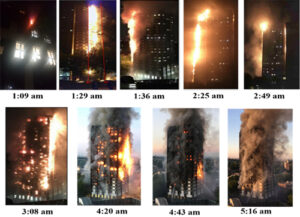
Kharkar spoke about the passive fire protection approach in fire safety. The use of non-combustible and/or Class 1 cladding systems will make the façade/cladding materials inherently safe. The “Real” behaviour of the entire façade system which is “As to be Installed”, which comprises of the facing, insulation, adhesives used for the attachments, and the structural elements can be put to test only in full-scale testing rather than in a specimen test.
Because fires spread quickly along vertical surfaces, and because enclosed vertical cavities, in particular, can stoke fires through a chimney effect, the façade systems must be designed so as not to create conditions that allow a fire to develop rapidly, adds Waltke. Additionally, in certain conditions, fires have been known to propagate from one level of a building to the next by breaching the façade and re-entering the building at the level above. Accordingly, façade systems must be designed to prevent this, however, fully sprinklered buildings are typically exempted from this requirement.
Façade material’s property and performance during fire emergencies matter a lot along with an appropriate installation technologies (including sealants), points out Ar. Chawhan. Grenfell Tower fire incident of 2017 is a good example to explain this. This structure had installed inappropriate façade material for exterior cladding which led to fire spread across the entire structure from exteriors, says Ar. Chawhan.
Key Factors To Prevent Fire And Its Spread
Smoke and heat are byproducts of the fire. It is these two which are responsible for casualties more than the fire itself, observes Ar. Chawhan. Hence it is essential to address façade openings, ventilators, etc. Norms do emphasise on having openings/ openable panels in the façade (10% usually) which, in an event of a fire can let out the smoke and heat. Once opened up, the exterior material of the façade should be equally good to not to catch fire/ spread fire further. Smoke seals at floor levels help to stop the spread to upper floors.

According to Ar. Dixit, to prevent fire and its spread, buildings should be equipped with accessible windows for rescuing, fire retard materials for the façade and ventilators within closed spaces so they don’t become a smoke well and expedite the spread of fire. Kharkar advices: If an existing building is evaluated and is concluded to have a combustible façade and is not economically viable to remove/replace the façade to a non-combustible or a Class 1 option, then some of the ways which could be adopted are listed as below:
- Providing vertical and horizontal fire breaks to help reduce the spread involving the combustible façade.
- Providing automatic sprinklers and flashing to avoid any exposed combustible insulation.
- Fire-resistant glass panels with frames along with firestop to avoid the spread of fire and smoke inside the building.
- Exploring options of fire retardant paints/coatings, which may inhibit fire growth.
Forced or natural ventilation systems may help in extracting the smoke from the façade system and avoiding its entry inside the building but it could contribute to fanning the fire. Hence, an otherwise controllable fire may spread because of the fresh oxygen supply from the ventilation system. According to Waltke, in some cases, particularly in buildings with multi-story atriums, one of the strategies for preventing the spread of fire is to ventilate the products of combustion (smoke and hot gasses) to the outdoor environment.
This greatly reduces the danger of these products to building occupants and prevents them from igniting other combustible materials within the building. When this strategy is implemented, typically the products of combustion are expelled from the building by mechanical ventilators on the roof, but the façade system plays an active role in providing the make-up air that allows these products to escape. Often the doors and windows on a façade are automatically opened by the fire alarm system when the smoke evacuation system is activated, thus allowing fresh air to replace the smoke and gasses that are expelled through the roof.
Some Important Aspects of Fire-Safety

Consider the majority of new constructions where the traditional brick walls with small window-to-wall ratios have been replaced by expansive glass, aluminium and stone façades. Fire-safe façades then become a pivotal aspect of design and final construction. According to Kachwala of FG Glass, some of the important aspects of fire-safety are:
- Adequate checks to ensure that only non-combustible materials and fire-retardant materials are used
- Horizontal and vertical fire-stops should be in place to check the propagation of fire within the floors and vertically between floors
- In the case of openable windows, the monolithic toughened glass should be installed. Laminated panes should be avoided as these would be difficult to break if need be during a fire
- All openable windows should be clearly marked with a red triangle, visible from outside
- All refuge areas (open or compartmentalised) should be provided with adequate ventilation through the façade, either through open space or through openable panels.
Although these are just some basic guidelines, eventually the building location, type, size, and its potential occupant density will demand additional fire-safety measures, ignoring which can pose a serious threat to the safety of its people, adds Kachwala. (Tariq Kachwala, Director, FG Glass)
The Importance Of ‘Perimeter Fire Barrier Systems’
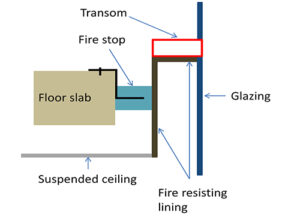
Every floor of a multi-story building must typically be designed as a fire-resistant assembly that prevents the fire from spreading from one level to the one above it for a certain period, notes Waltke. Perimeter fire barrier systems are used in curtainwall conditions where the exterior façade assembly bypasses the structural slab. These systems, which are also known as fire-resistive joint systems, serve to contain a fire at the gap between the slab edge and the façade assembly and provide the same level of fire resistance as the floor slab.
Void spaces or cavities between the façade and the floors need to be completely sealed through the use of perimeter fire barrier systems, points out Kanchwala. These systems typically consist of firestop sprays, smoke seals and rock wool insulation to ensure that the cavity is completely sealed and to stop the vertical spread of fire between floors, for the duration as required by the fire department or building codes.
According to Kharkar, perimeter protection systems are the first line defence and as such are very critical when it comes to reducing the spread of the fire. They essentially work on the principle of cutting the heat feedback thus preventing the fire to enter the building. In some cases, under very specific conditions, automatic sprinklers provided inside the building can also effectively work as barriers to fire spread, notes Kharkar.
The most common example of such protection is the widow sprinkler or in earlier days referred to as a water curtain or a “Drencher” system. In an industrial set up when openings in the otherwise segregated spaced cannot be avoided, sprinklers or deluge systems are provided and have been effective in controlling the fire spread. E.g., openings for the conveying systems. One of the options to mitigate the fire and smoke exposure from combustible façades is to have external automatic sprinklers, adds Kharkar.
Fire Safety – Role Played By Building Plans & Layouts
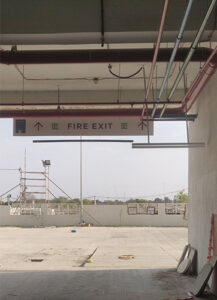
In any event of a disaster, life safety is a priority. In an event of a fire, points out Ar. Chawhan, the following things matter a lot – Containing the fire, evacuating the occupants from the zone and engaging the active mechanisms of firefighting. Hence at all stages mentioned, overall layout with essential provisions is extremely necessary. Fire fighting is essentially a coordinated and well-planned system with active and passive means of life safety.
According to Waltke, building occupants must be informed about the quick exit ways in the event of a fire. Multi-story buildings typically must also provide more than one exit for occupants of floors. Buildings must be designed to provide suitable separation between exits so that fire does not prevent access to more than one exit. For certain conditions, buildings must also be separated into compartments by fire barriers that can contain a fire.
Ar. Anuprita Dixit mentions that NBC, DCR and many other building code manuals have mentioned special requirements for fire safety. Fire safety norms, exit routes norms, and norms on combustible materials should not be flouted. All buildings need to follow the fire safety norms at the planning stage. For instance, fire staircases and emergency exits should be planned in the building such that the travel distance on each floor shall not exceed 15 metres. Further, the fire escape shall be constructed of non-combustible materials and should have a straight flight not less than 125 cm wide with 25cm treads and risers not more than 19 cm (according to NBC).
According to Ankit Sharma, once a fire has started, the main challenges are to control the fire spread and extinguish it in the early stages itself and provide safe escape routes for evacuation. If the building is well-designed using efficient active and passive protection systems, it may help to minimise the fire spread to other parts of the building. A good building design also provides clear pathways for the safer and quicker evacuation of occupants.
The Choice Of Materials Like Sealants Considering Fire Safety
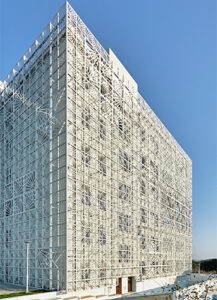
Ideally, the use of non-combustible options such as mineral wool sandwiched between metal facing/ masonry brick with plain concrete are preferred. It could be gypsum boards, providing the same fire rating of the wall. Even the use of Plaster of Paris (POP) can suffice the requirement, says Kharkar. If for some reason these cannot be used, then products tested by an independent third-party to the requirements of UL1479/FM4990 can also find their application within their limitations. Here again, a listed/approved contractor needs to be employed else the listing/ approval is void.
These sealants are often used in conjunction with fire-resistive materials like mineral wool insulation to infill these gaps, thus preventing smoke and hot gasses of combustion from passing through the gap. Some of these sealants, says Waltke, simply create a membrane that prevents smoke and hot gasses from passing through a joint, and others use intumescent materials that swell when heated, thus sealing a gap in the event of a fire. In either case, the sealant must be tested and listed for this purpose by a safety certification organisation such as Underwriter’s Laboratories.
The Guidelines, Standards & Norms For Fire-Safe Facade Materials & Installation
According to Ar. Chawhan, firefighting is essentially a set of measures, which includes a combination of active means (sprinklers, fire tanks, fire risers, etc.) and passive means (partitions to contain fire and heat, fire rated assemblies, passages and corridors for evacuation, etc.). The norms laid down are more of performance and design provision specific. It uses terms like fire-rated, non-combustible, fire-resisting materials and installations. It provides for the minimum size required for stairs, passages, etc. to suit the purpose.
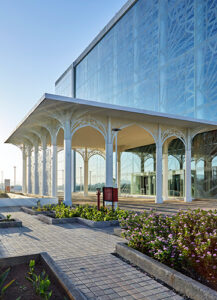
It also provides for an exhaustive list of materials with their fire properties like calorific values, ignition temperatures, etc. A designer has to arrive at an appropriate solution to suit the performance parameters of the design using these guidelines. The National Building Code (NBC) specifies guidelines for the demarcation of fire zones and, restrictions on construction of buildings in each fire zone. It also classifies buildings based on occupancy type and according to the fire resistance of the structural and non-structural components and other provisions (fire alarms, shafts, hoses, escape routes) that prevent danger from fire, smoke and fumes, says Ar. Dixit. The code is regularly revised and kept up to date with modern construction methods and materials.
Part 4 of The National Building Code 2016 is dedicated to Fire and Life Safety and the hundred-plus page document is a comprehensive and useful guideline for fire-safety in building constructions, adds Kachwala. The document provides detailed information on both active and passive fire strategies. Detailed design specifications for applications like lift lobbies, staircases, escalators, refuge areas, fire egresses, fire doors and car parking are meticulously defined and should be followed by developers in form and spirit.
According to Kharkar, the current version of NBC 2016 mentions the use of noncombustible materials. It does specify the requirement of low flame spread requirement when it comes to wall finishings but does not do so for the wall types. It does not specifically restrict the use of fire-rated materials for non-load bearing walls like the building façades.

In Kharkar’s opinion, it should specifically state, for façades, only use non-combustible/ Class 1/assemblies passing the test standards mentioned below, taking note of the height restrictions/other restrictions derived from the full-scale testing. Some of the standards to which the cladding systems can be tested are:
- NFPA285- Standard for fire test method for evaluation of fire propagation characteristics of exterior wall assemblies containing combustible components
- BS8414 Part 2-Façade testing
- Nordic Countries-SP105-Façade testing
- Parallel Panel Tests (PPT) using FM4880
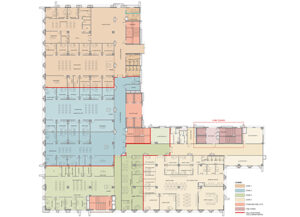
(Note: Classification based on desktop analysis and/or small scale/specimen tests should not be considered as yardsticks for acceptance.) In the United Kingdom, post- Grenfell tragedy, there is a wider agreement on the use of noncombustible façades, adds Kharkar.
In the United States of America, the International Building Code (IBC) and NFPA5000 reference NFPA285 “Standard for Fire Test Method for Evaluation of Fire Propagation Characteristics of Exterior Wall Assemblies Containing Combustible Components” which is largely the norm in the United States of America. Many also comply with FM4880 and the Parallel Panel Test developed by FM Global.
The Key Factors to Consider During Façade & Fenestration Design & Installation
Ar. Chawhan lists the following as the key factors:
- Use of fire-rated façade materials (fire class as per design requirements) with an appropriate installation technology.
- To prevent the spread of fire through exterior skin, one should have provisions for smoke seals/ fire seals at floor levels and adjoining space separators
- Provision for openable units in façade to vent our smoke and heat
The Use of Fire-Rated Glass
The use of fire-rated glass as a choice for constructing compartments, glazed doors, glazed partitions and smoke seals is seeing an upward trend in our country, observes Kanchwala. This is due to their durability, ease of maintenance, aesthetics and transparency – all unsurpassed by any other building material.

Today, lobby glazings and office compartment partitions are almost entirely constructed of glazed partitions and glazed doors instead of the traditional steel and brick-and-mortar constructions. Not only do they enhance the livability index for occupants by providing a sense of openness, but they also play an important role during fire-rescue if they remain transparent during a fire (transparency in fire conditions should be an indispensable part of fire-rated glass selection).
Fire-resistant glass may be used within a fire barrier assembly, thus forming a part of the fire compartment, points out Waltke. Firerated glass is used where a fire barrier must be maintained, but there is a desire for a visual connection between one fire compartment and the next. Fire-rated glass may be used to enclose fire exit stairs, enclose fire-rated elevator lobbies, or provide a visual connection through a fire barrier for functional or aesthetic purposes.
Special Policies/ Specifications By The Government/NBC For Choice Of Facade Materials
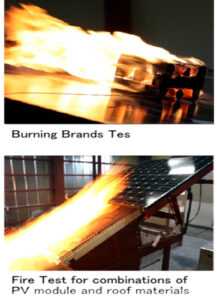
According to Kachwala, firerated glass is gaining increasing popularity with its superior aesthetics and fire-stopping capabilities. In almost every application, like walls, partitions, skylights, refuge area separations, compartmentation, smoke seals, doors and lifts, fire-rated glass can substitute traditional building materials like wood, steel and gypsum boards. The National Building Code 2016 warrants insulation for 20 minutes only in fire-doors leading to the exits, and in every other application, a 120-minute fire-rated glass (uninsulated or insulated) can be used.
According to Ar. Chawhan norms/ policies/ specifications are more about how a required system should perform in an event of a fire. Façade (including glass, ACP or any cladding material) is a part of the overall firefighting system. Though façade (design, testing and fabrication) is a new professional expertise, it is still bound by the duties of life safety of occupants. Hence, even if there are no strong façade specific guidelines at the national level, it still comes under the purview of fire safety guidelines. When façade specific standards in India are available, then firefighting and other life safety norms can be aligned/modified/ revised with it.
Kharkar adds that the stakeholders such as the architects/ consultants and the occupier should accept the cladding only if the test certificate clearly mentions the tested assembly as it will be erected on site and the same assembly passes the requirement laid down in the code. This document will be the part of the submission to the local authority seeking conditional ‘No Objection Certificate’ and thereafter the occupancy certificate.
Conclusion:

The problem of occupant fire safety in buildings has received considerable, albeit belated, attention in recent years. With so many accidental and nonaccidental fires occurring in the different parts of the world and the incidents of the recent past, building fire safety is a concern. Fire safety provisions in ultra high-rise buildings should be designed carefully. Studying the above would help to work out an appropriate fire safety design to give adequate public safety. A comprehensive fire risk assessment is very important in dense urban areas as it provides an estimation of people at risk and property. Fire policy and mitigation strategies in developing countries are constrained by inadequate information, which is mainly due to a lack of capacity and resources for data collection, analysis, and modelling.
